BENELLI 354 RACE REPLICA

Purchase
Back in 1989 I remember listening to a 250 4-cylinder Benelli race replica belonging to ex-racer Terry Grotefield, which had a road engine. Then when I recently stumbled on a picture of a similar 500cc bike with four beautiful, sculpted exhausts, I knew I wanted to build one.
I started looking for a suitable base bike. The most common 'quattro', although still a rare bike in the UK, is a 354. A little research revealed they are none too powerful, but they do rev quite well, which would be good for a sexy exhaust note - one of the major reasons for building the bike. I bid on a fairly scruffy bike on eBay but it went for more than I was prepared to pay.
I then turned my attention to a 1982 354T advertised by Newcastle dealers M&S, a non-runner they had imported from Spain. It looked pretty fair in the pictures, and after confirming the engine at least turned over by hand I struck a deal for £1850, well below what they were originally asking. The bike was delivered while I was working in the UK, so I bad little chance to examine it as I loaded it into my van, other than to notice that both brakes were inoperative.
Inspection and Stripdown
Proper inspection had to wait till I had it back in my garage in the Isle of Man, but pretty soon I was panicking. Various engine plates and bolts were missing, along with two out of four of the bolts in the fork yokes. The exhausts were hanging off with no collets and only four out of eight studs still in the head. The carbs were loose, and two float bowls fell off as I was removing them, inspection revealing that the thread in the aluminium body had degenerated with age on all four.
Perhaps worst of all the engine had been left with no oil for many years, and I couldn't even get the cam cover off easily to look at the internals because several allen bolts were rounded off. Yet at the same time it had new tyres fitted, and the wheels had been repainted.
I realised that, rather than a bike that just hadn't been run for something like a decade, this was a bitsa that someone had thrown together all those years ago and never even ridden. I couldn't even check whether the engine number was original, but it seemed likely to be a replacement.
I contacted M&S and, once they realised I wasn't just trying it on, they offered to let me return it. But to put everything back together and deliver it back was not a sensible option, so we agreed a £250 refund on the price. Everything would depend on the condition of the engine, but the first good news was that the sump was completely free of sludge, with just a few traces of clean oil. It seemed that maybe this was a rebuilt engine. The wet clutch seemed all ok, and when I finally removed the rounded bolts and the cam cover it all looked pretty good inside there too. Maybe the warm Spanish climate had protected it for all those years?
Emboldened I fitted new rubber gaskets supplied by UK classic Benelli specialists Selwyn Motorcycles in Haverhill, Suffolk, filled it with clean oil and connected the starter to a battery. Good news! It turned over beautifully. So fingers crossed it might be ok after all.
Frame, Swinging Arm and Rear Units
The rest of the stripdown was fairly straightforward, after which I cut or ground off all the redundant lugs and brackets, smoothed off the underlying frame and took it and the swinging arm to Ian Tunney at Manx Powder Coating in Union Mills, who had done such a good job on my Aermacchi. He blasted it and coated it in gloss black, and it looked terrific.
Unfortunately I didn't realise the swinging arm bushes were nylon and they shrunk with the heat so, with replacements hard to come by, I bought some Nylon 66 bar and had a new pair turned up on a lathe. I also fitted new RFY gas shocks, which worked well on the Aermacchi and are incredible value.
Forks and Yokes
The 30mm Ceriani forks had been painted grey, so I ground them back to bare metal with a rotary wire brush. I cut the handlebar boss off from the top yoke and ground it smooth, at the same time removing the black paint from it and the bottom yoke, before taking the whole lot to Dave Sells at Manx Metal Polishing in Ballaugh, who brought it all to a beautiful, better-than-new, mirror finish.
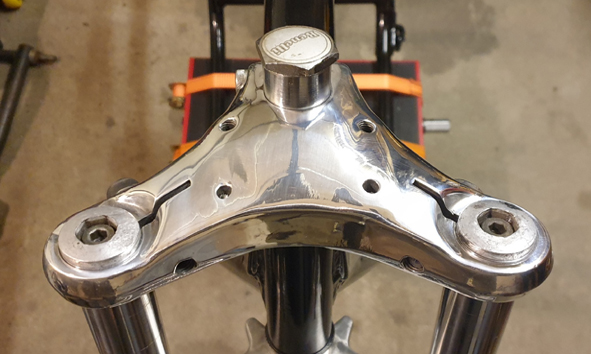
Wheels, Tyres and Brakes
Switching to spoked wheels and drum brakes to make a more faithfull replica was always going to be beyond my budget, so I decided to stick with the original (and incredibly heavy!) spoked wheels and discs setup for a more modern twist. So they were all stripped, rubbed down and sprayed gold, and new Metzeler ME22 tubed tyres fitted, increasing the size to a 3.25 x 18 front and a 3.50 x 18 rear.
Meanwhile the original linked braking system was abandoned in favour of a more conventional setup, necessitating the purchase of an inexpensive new, universal, rear master cylinder that bolted perfectly to the original frame lug, along with a similar master at the front with adjustable lever. The callipers were all stripped and rebuilt with new seals, along with fitting bespoke HEL braided hoses.
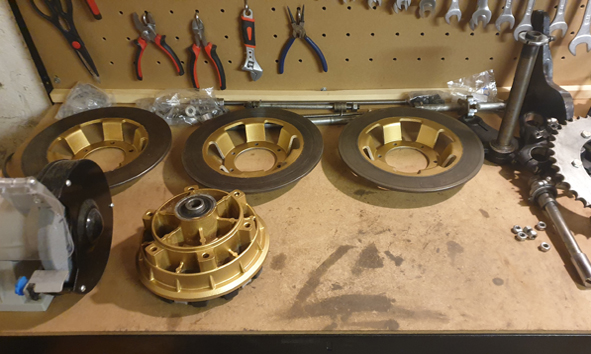
Engine
The missing bolts and plates were again supplied by Selwyn, with a shorter rear mounting bolt made up because the footrests are no longer mounted at each end. After which the engine was refitted in the frame.
Carburretors
Fortunately the internals of the four VHB 20 Dell'Orto's were relatively clean, while the jets were mostly clear too. The decaying main-jet/float chamber bolt holes in the body were drilled, tapped and helicoiled. Meanwhile standard-sized main, pilot and needle jets replaced any odd-sized originals, along with new sealing rubbers for the float chambers, all supplied by Eurocarb in the UK.
The original manifold rubbers were badly split underneath copious amounts of tape, but replacements were sourced from Gutsibits in Huddersfield, because many parts for 4-cylinder Benellis are common with those for Guzzi GTS models made when Alejandro de Tomaso owned both companies. New jubilee clips were also fitted, along with inexpensive pod filters, longer for the two centre carbs (but 2/3 taped up to keep the jetting the same) but shorter for the two outside carbs.
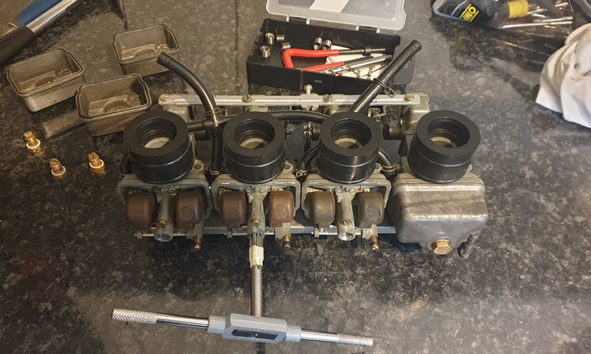
Footrests, Handlebars and Bodywork
New universal clip-ons, twist-grip, levers and rear-sets were inexpensively sourced. The latter were fitted to the rear footrest brackets, and bespoke linkages made up for the gearchange (using a 354 Sport front splined arm) and the new rear calliper. The rear mudguard and seat were bolted to the frame cross member, while the tank was fitted via bespoke brackets at the front and a thick rubber band attached to the rear mudguard at the back. All bodywork was supplied by the excellent Motoforza in Czechoslovakia.
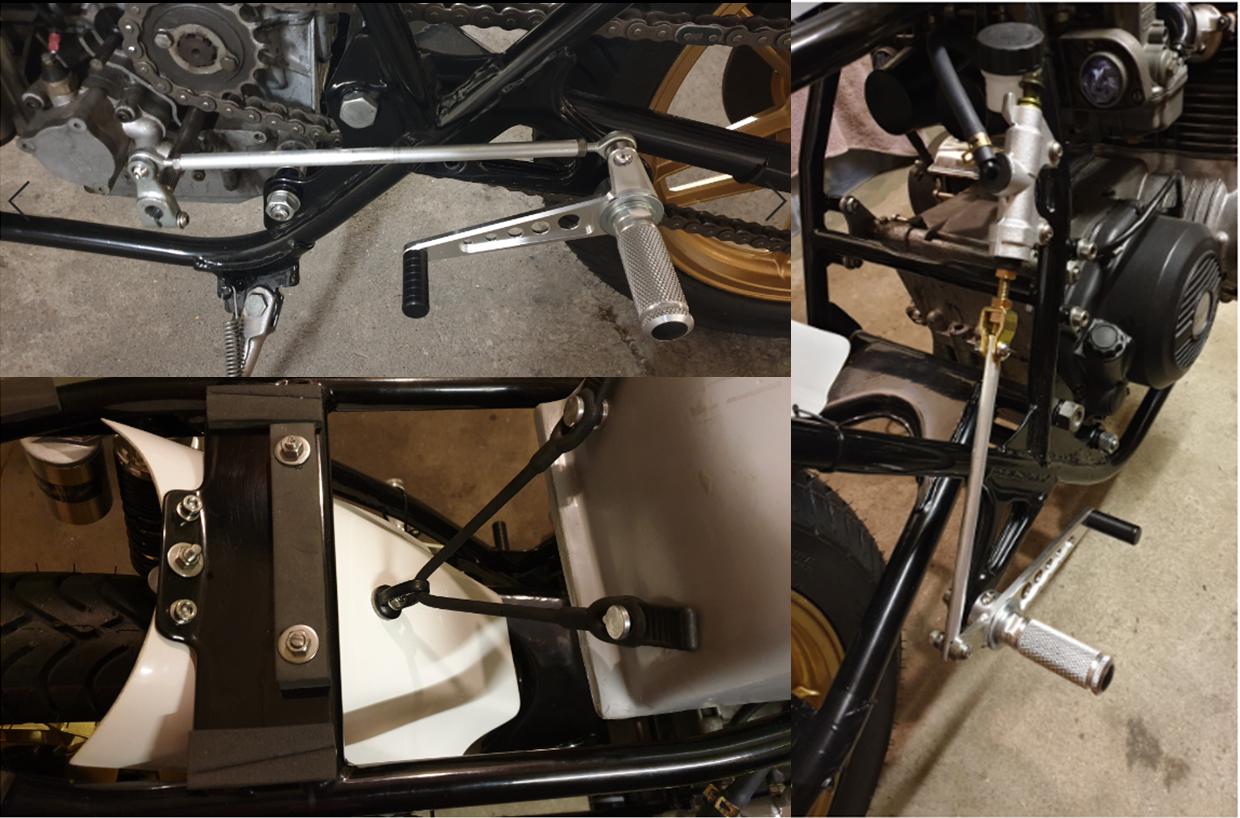
Exhausts
Beautiful, sculpted race-replica tailpipes were obtained from John Clarijs in Holland (john@on.nl) for only 435 Euros. These were mounted in the same way as the race bikes, with the two pipes on each side attached to each other with triangulated brackets at the rear, and alumimium bar struts hanging from holes drilled in the front of the rear footrest plates for the inside pipe on each side, and from a triangulated nylon bracket bolted to the frame downtube for the outside pipe on each side.
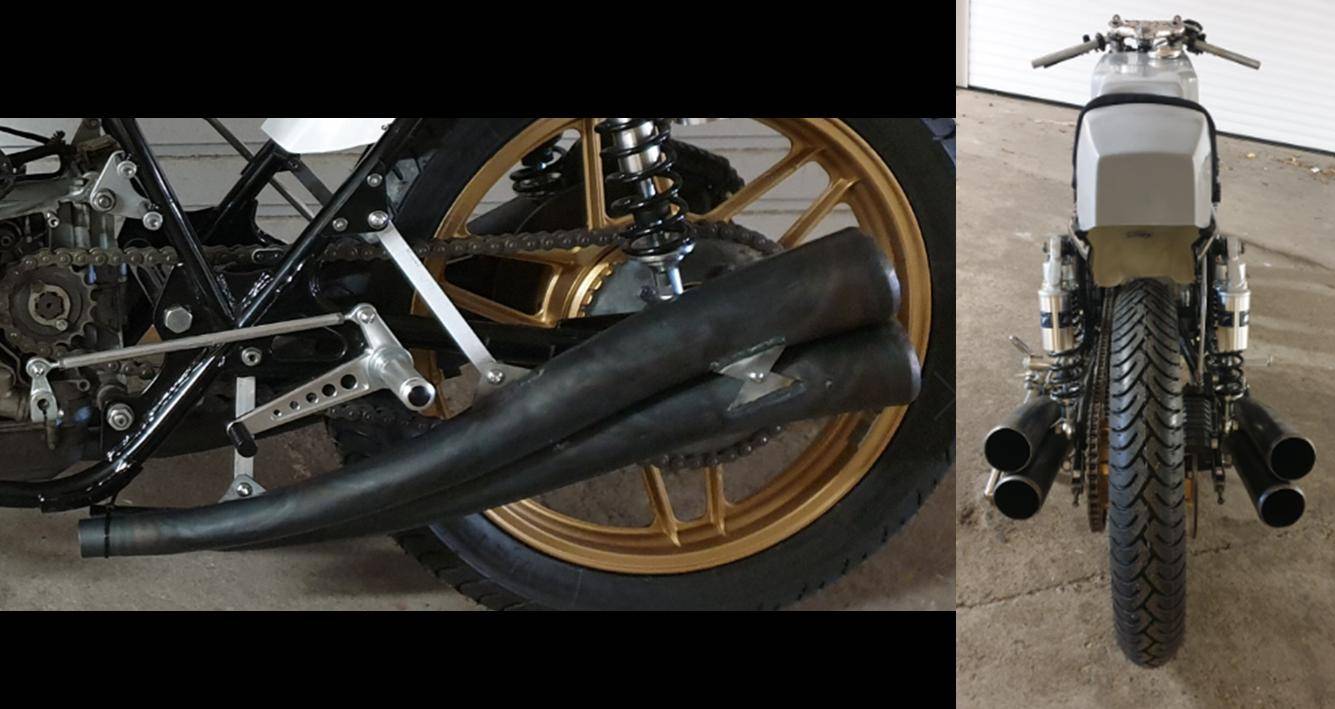
Fairing and Paint
A vivid turquise-green was chosen for the bodywork, in an attempt to match the most vibrant race bikes. Originally a fairing of any sort wasn't planned, but as time went by a full replica race fairing as again provided by Motoforza looked like the right way to present the bike properly. After excavating a large hole for the alternator on the left side, it was fitted using a universal race front mount and home made side brackets. The bodywork was painted locally by Tom at Autobodies, while bespoke tank and fairing decals were self-designed and printed by the Copy Shop in Douglas.
Electrics
Having sorted the cosmetics, it was time to get to grips with the electrics. I had toyed with the idea of fitting lights and a full loom, but with a full fairing it was clear that the race-replica look was what I was after. So I decided to construct a minimal wiring loom from scratch, having consulted various basic cafe racer wiring diagrams. This was actually easier than I anticipated, especially after I put together a proper wiring diagram. All the main components - an aftermarket 3-phase, 8-wire regulator-rectifier, starter relay and main fuse - were fitted around the outside of a stainless lithium battery box bolted to the frame cross member behind the engine. A second-hand Acewell Ace formed the main instrumentation, alongside an on-off and starter switch from a more modern bike. Meanwhile the conventional points were replaced with a Newtronic electronic system.
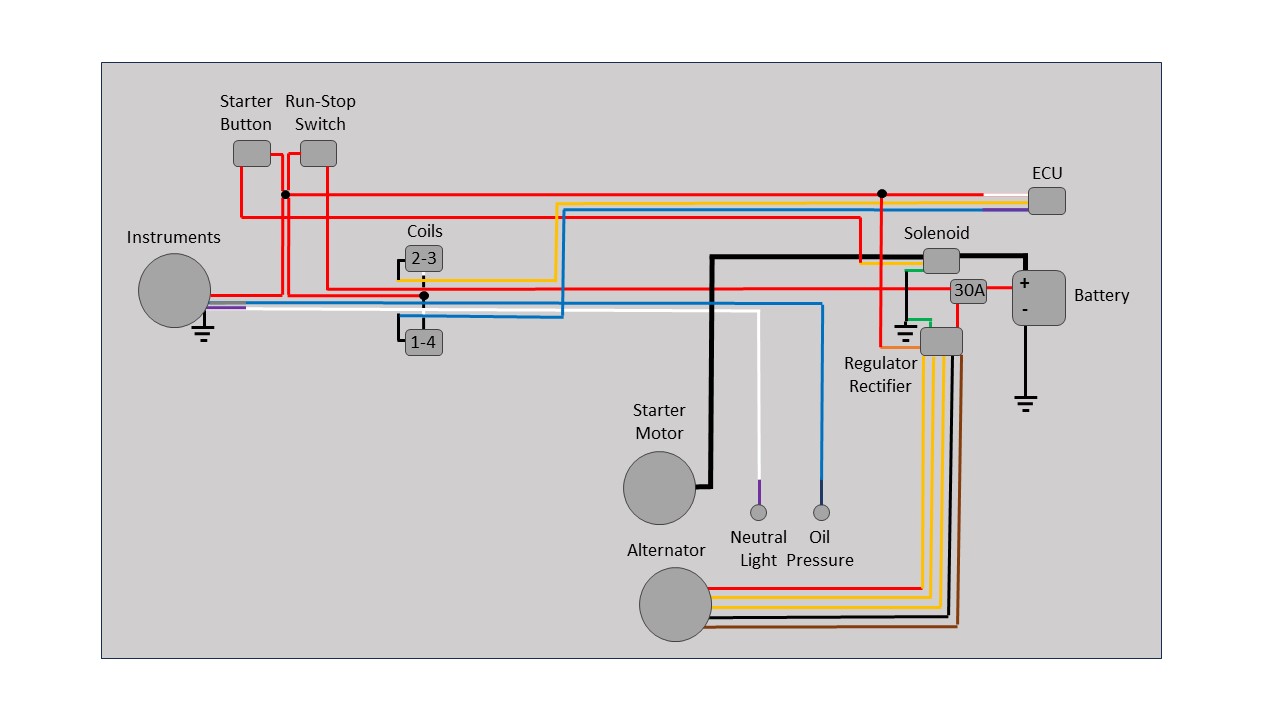
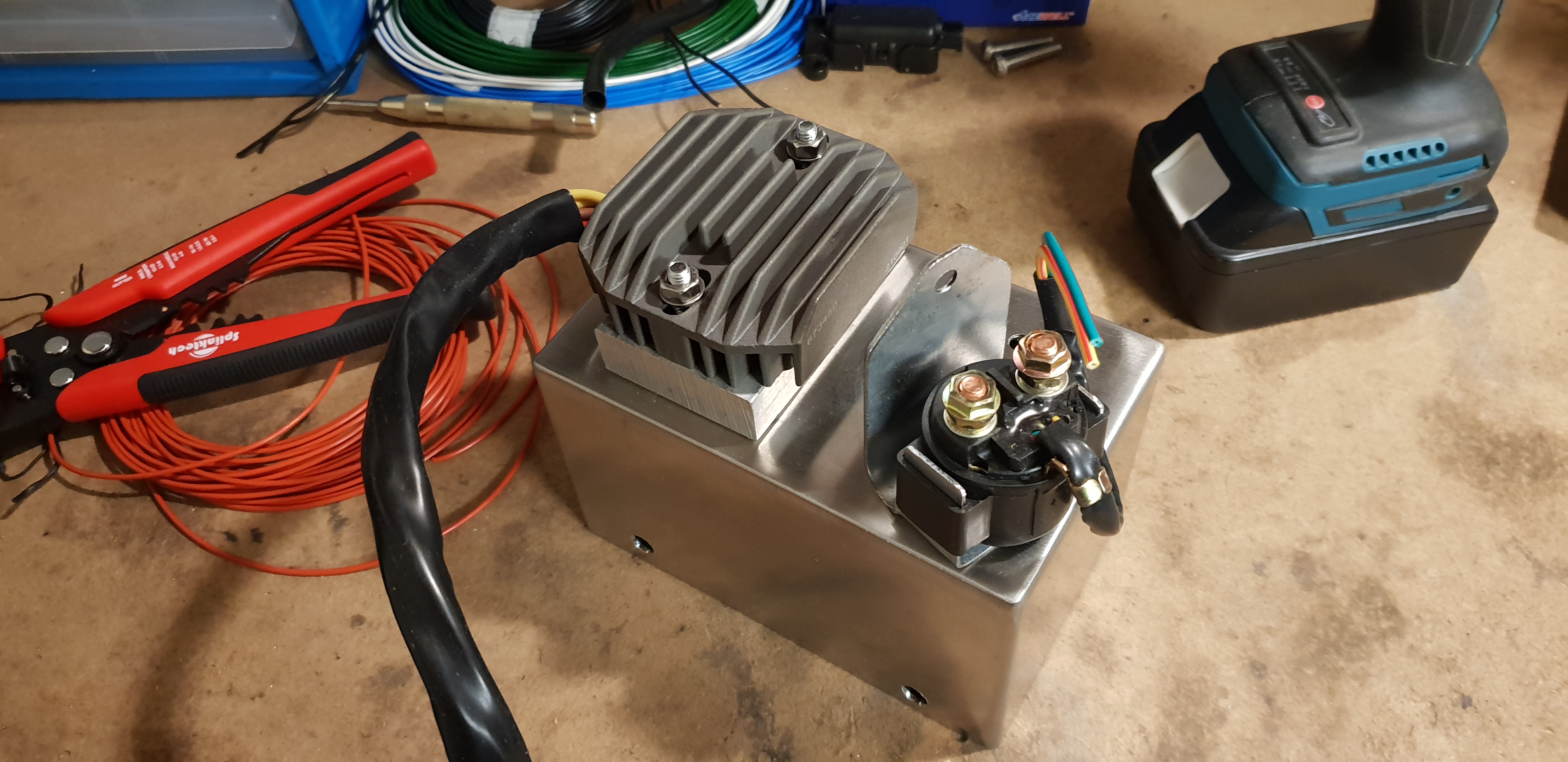
Starting...
While attempting to start the bike proved that all the electrics were working, it absolutely refused to fire up. It turned out the compression was equally low on all four cylinders. I knew I had timed the cam correctly, I checked that the valves and seats were fine, and the head gasket was fine. So I removed the barrels, had them lightly honed, and renewed the rings. Sadly this made no difference, and I could only assume the bores were worn and needed oversize pistons. This work then took a back seat while I got on with other builds...
